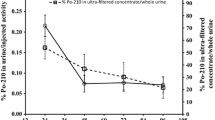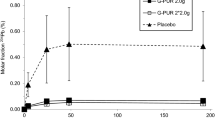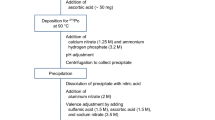Summary
Polonium-210 is one of the most hazardous radionuclides. As recently as 1988, there have been concerns regarding accidental exposures of humans to it. Yet, there have been no studies on the effectiveness of the newer dithiol chelating agents in increasing the excretion of this radioactive heavy metal. In order to accomplish this, a safe and effective method for determining the radioactivity of polonium-210, an a emitter, in the feces was developed. The excretion of polonium-210 was studied by giving male Sprague-Dawley rats210Po (3.33 × 107 cpm/kg, intraperitoneal); 1 h later they were given either 5% sodium bicarbonate,N-(2,3-dimercap-topropyl)phthalamidic acid (DMPA) ormeso-dimercaptosuccinic acid (DMSA) (0.20 mmol/kg, subcutaneous). Treatment was repeated daily for 12 days. DMPA and DMSA increased the urinary excretion of210Po, as compared to control animals, 8-fold and 5-fold, respectively. DMPA increased the fecal excretion of210Po compared to the other treatments and also decreased the level of210Po in the spleen, a radiosensitive organ. DMPA (0.20 mmol/kg, intravenous) increased biliary levels of210Po 5-fold compared to controls. The results indicate that DMPA has greater specificity in chelating and increasing the excretion of210Po than DMSA.
Similar content being viewed by others

References
Aposhian HV, Dart RC, Aposhian MM, Dawson BV (1987) Tissue decorporation of polonium-210 in rats by DMPA. Res Commun Chem Pathol Pharmacol 58:157–171
Beardsley T (1983) Windscale 1957 accident. Nature 305:351
Fink RM (1950) Biological studies with polonium, radium and plutonium. McGraw Hill, New York, pp 35–156
Hursh JB (1952a) The effect of BAL on the excretion and tissue distribution of polonium in rats. J Pharmacol Exp Ther 103:450–459
Hursh JB (1952b) Effect of BAL on survival of rats after lethal doses of polonium. Proc Soc Exp Biol Med 79:210–212
Klaassen CK (1980) Heavy metals and heavy-metal antagonists. In: Gilman AG, Goodman LS, Gilman A (eds) The pharmacological basis of therapeutics, 6th edn. MacMillan, New York, pp 1615–1637
Lanzola EE, Allegrini ME, Taylor DM (1973) The binding of polonium-210 to rat tissues. Radiat Res 56:370–384
Moroz BB, Parfenov YD (1972) Metabolism and biological effects of polonium-210. Atomic Energy Rev 10:175
New York Times (1988) US detects radioactive leaks at three more plants, February 11, 1988
Parfenov YD (1974) Polonium-210 in the environment and in the human organism. Atomic Energy Rev 12:75–143
Sidel A, Volf V (1972) Rapid determination of some transuranium elements in biological material by liquid scintillation counting. Int J Appl Radiat Isotopes 23:1–4
Stara JF, Nelson NS, Della Rosa RJ, Bustad LK (1971) Comparative metabolism of radionuclides in mammals: a review. Health Phys 20:113–137
Yelton DB, Aposhian HV (1972) Polyoma pseudovirions I. Sequence of events in primary mouse embryo cells leading to pseudovirus production. J Virol 10:340–347
Zheng W, Maiorino RM, Brendel K, Aposhian HV (1990) Determination and metabolism of dithiol chelating agents VII. Biliary excretion of dithiols and their interactions with cadmium and metallothionein. Fund Appl Toxicol 14:598–607
Author information
Authors and Affiliations
Rights and permissions
About this article
Cite this article
Bogdan, G.M., Aposhian, H.V. N-(2,3-Dimercaptopropyl)phthalamidic acid (DMPA) increases polonium-210 excretion. Biol Metals 3, 232–236 (1990). https://doi.org/10.1007/BF01140585
Received:
Issue Date:
DOI: https://doi.org/10.1007/BF01140585



